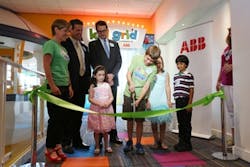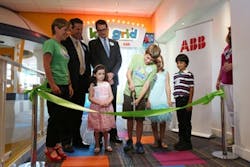STEM Children's Museum Exhibit Powers up Energy Education Through Play
A million dollar gift from ABB funds interactive play to teach future engineers about the power grid, electricity and safety.Companies are stepping up to encourage future engineers because the U.S. is said to be lagging behind so many other countries in science and math education.
Global power and automation leader ABB and Marbles Kids Museum are launching a one-of-a-kind, play-based power grid exhibit, called Kid Grid, to generate interest in science, technology, engineering and math (STEM) in young children. Kid Grid is located at Marbles Kids Museum in Raleigh, N.C., and opened late May. ABB gave the funds in the form of a $1 million grant.Kid Grid's goal is to playfully introduce young children to electricity and power grid technology through hands-on and mind play.Kids explore a pretend power grid and learn how to make smart energy choices. The exhibit promotes early learning in science, technology, engineering and math (STEM) education, inspiring the next generation of great minds through interaction and energy stimulation to power up a bright futureEngineering companies have a vested interest in maintaining an educated workforce in the U.S. and breaking through traditional gender stereotypes. A current shortage of American engineering graduates leaves many hi-tech companies with a struggle to fill jobs. In 2012, high school students from 29 industrialized nations outperformed the U.S. in math, and 22 nations outplaced the U.S. in science. Projects, such as Kid Grid, are designed to give children positive encouragement in STEM education at an early age.Although the demand for highly skilled workers in STEM fields currently outpaces supply, STEM Advantage, a non-profit coalition, said that STEM-related jobs are anticipated to increase by nearly 17 percent over the next decade.Of the jobs currently filled across the United States, the percentage that will require STEM education is expected to grow to more than 20 percent by 2018.STEM industry jobs offer benefits of their own.According to the U.S. Department of Commerce and Economics and Statistics Administration, individuals employed in STEM jobs consistently earn wages up to 26 percent higher than their non-STEM counterparts. In fact, eight of the top ten college degrees, as ranked by income, were in STEM fields.During the initial design of the grid, ABB employees and families collaborated with Team Marbles and brainstormed creative ways to get kids talking about energy.Engineers and experts from ABB continued to provide guidance and knowledge throughout design and construction to ensure that Kid Grid would accurately reflect a real power grid.Kid Grid is complete with play versions of cables, control systems, motors, towers and transformers and real equipment provided by ABB."It is our hope that by engaging children at a young age, we can inspire them for a lifetime," said Greg Scheu, CEO of ABB North America. "At ABB, we think a lot of the discrepancy between the U.S. and other nations lies in the lack of


